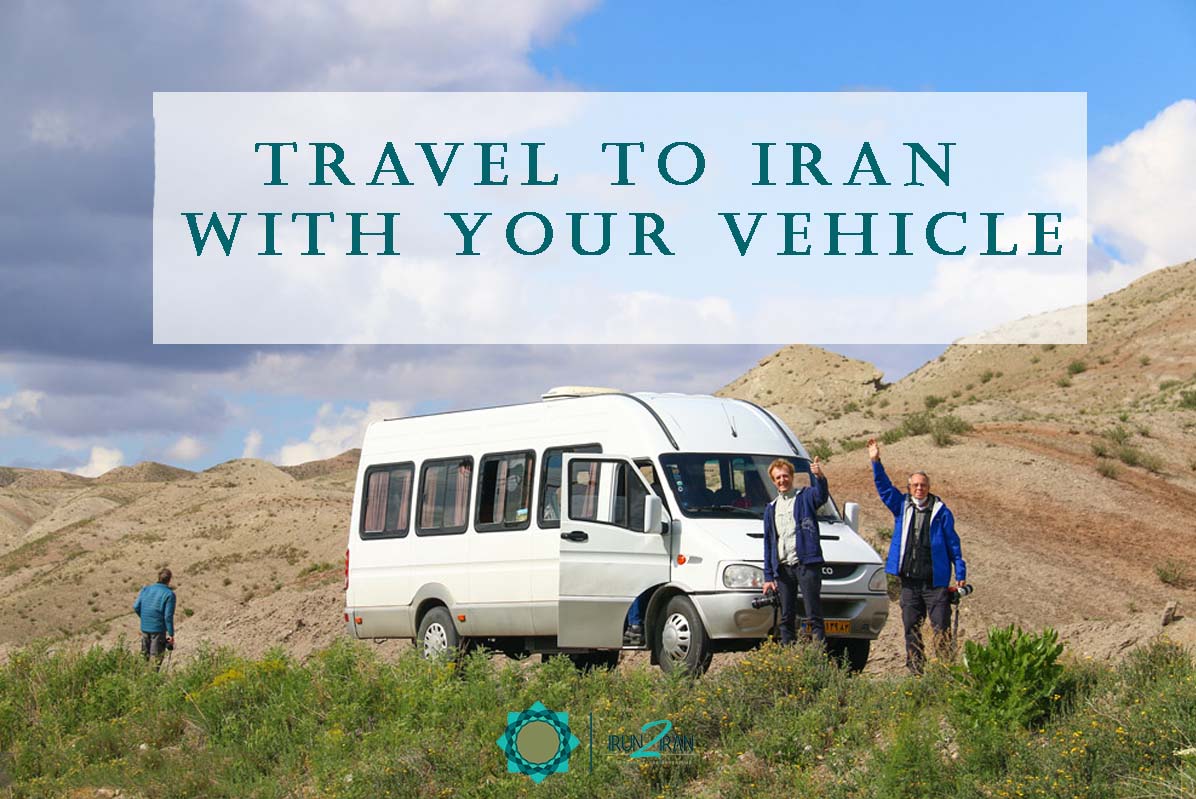Travel to Iran by car is an opportunity to experience the country’s stunning landscapes, engage with the local culture of cities and villages to create unforgettable memories. To fulfill the purpose of a road trip to Iran, it is essential to get familiar with the necessary steps, facilities, regulations and rules to have a hassle-free travel to Iran by road.
Why Travel to Iran by Your Car

Travel to Iran by road offers flexibility and the opportunity to explore the country’s diverse landscapes and attractions at your own pace. Beyond that, you will have the freedom of selecting any route or stop halfway to admire the beauty or get some coffee. By traveling to Iran by your own car, you will have the chance to experience local culture, visit less accessible areas, and enjoy scenic cities and countryside.
Compared to traveling by other means of transport, travel to Iran by car and camper helps you save more money on transportation costs, especially if you are traveling in two, three or four people in one car.
In addition, you can carry more luggage and necessary camping and cooking equipment in your car to save more money on accommodation and dinning.
read also: Solo Travel in Iran vs Tours in Iran
Steps to Vehicle Temporary Entrance to Iran
If you want to enter Iran with your private vehicle, there are some important steps you need to follow. The process usually involves applying for a Carnet de Passage, a document that serves as a temporary import permit for vehicles, as well as ensuring that your vehicle meets the necessary requirements for importation. In addition, for a road trip to Iran you need to familiarize yourself with the traffic rules and regulations in Iran, as well as the accommodations and services available along the country’s roads.
Borders of Iran for Entering by Car
When you decide to travel to Iran by private car, you need to know which border to enter and exit from. Iran located in Southwest Asia has borders with Armenia, Azerbaijan, Turkmenistan, Afghanistan, Pakistan, Turkey, Iraq, and the Caspian Sea, the Persian Gulf, and the Oman Ocean. Before the vehicle temporary entrance to Iran, check if the border you aim to cross is open since sometimes there may be limitations. Here is a list of the top border crossing points all around Iran that you may need to know for a road trip to Iran:
Turkey: Located in the west, the busiest crossing point is Gurbulak/Bazargan. But there is Esendere/Sero and Kapikoy/Razi borders as well.
Armenia: Located in the northwest, the sole land border is Agarak/Nordooz.
Azerbaijan: Located in the northwest, there are Astara/Astara and Bilasuvar/Bileh Savar borders.
Iraq: Located in the southwest, Iraq has 3 main border crossing points with Iran. The Zurbatiyah/Shlamcheh, Haj Omran/Piranshahr and Penjwen/Bashmakh. Due to ongoing security concerns, travelers should check the latest advisories before using this border.
Afghanistan: Located in the East, Islam Qala/Dogharoun is a busy border crossing point of Iran with Afghanistan.
Pakistan: Located in the East, Taftan/Mirjaveh is the most important border crossings.
Turkmenistan: Located in the Northeast, you can cross 2 borders from Turkmenistan into Iran, Gaudan/Bajgiran and Sarahs/Serakhs borders.
Read More : Traveling to Iran by Land
Carnet de Passage, Needed Permissions to Pass Iran Borders
A border pass booklet known as Carnet de Passages en Douane (CPD) is mandatory for the Vehicle Temporary Entrance to Iran (camper, van, car, motorbike) into Iran. The carnet de passage allows you to temporarily import your vehicle into the country without paying customs duties. To travel to Iran by private car, you can get a valid Carnet de passage either from a reliable automobile club in your country of origin or get a temporary Carnet de passage at Iran border. In both cases you need to apply in advance and provide documents.
Getting the carnet de passage at the border is actually easy and less complicated than you might think. You need to follow these steps:
- Send us your documents including visa, car document and driver’s license
- Arrive at the border early in the morning
- Wait for 3-4 hours to do all the customs paperwork
- Drive into Iran
Traffic Rules in Iran
Travel to Iran by private car needs you to be vigilant about the rules. Various key traffic rules and regulations apply to locals and tourists driving a car in Iran.
- As a rule of thumb, having a valid international driving license and carrying the necessary documents, including vehicle registration and third-party insurance, is important.
- Driving takes place on the right side of the road; women are authorized to drive a car and the driver has to be over 18 years old.
- Seat belts are mandatory for all passengers, and consuming alcohol and using a mobile phone while driving is prohibited.
- Speed limits typically include 60 km/h in cities and 110 km/h on highways, but these can vary.
- Road conditions may vary, so be cautious, especially in rural areas.
read also: Travel to Iran from Pakistan by Road
Accommodations on the roads of Iran
When travel to Iran by car and camper, you have extremely wide accommodation options suitable for any budget. From luxurious and modern hotels in big cities to traditional guesthouses and authentic ecolodges in rural areas.
When traveling by car, accommodation with private parking area provides more peace, however based on the experience, that is better to select the hotels with outdoor car park rather than the covered underground car park. Additionally, you might find some roadside motels and lodges convenient for travelers with cars.
As the last option you may set up a tent at the parks. It is secured and equipped with water and toilets, and it is free! However, it is not legal to set up a tent everywhere in the cities.
read also: Can you get an Iran visa without accommodation in a hotel?
Fueling Stations & Fuel Price
Another issue that should be considered when you want to travel to Iran by private car is the price of fuel. The price of diesel in Iran, as an oil-rich country, is so low that you can fill the tank with less than 15 dollars. But recently, a diesel card is started to be offered at the borders; it costs about $250. More than that, don’t be surprised if you are asked to pay some other amounts when leaving the country.
Make sure the tank is filled with enough diesel before entering Iran with own vehicle since it may take a while to reach the first diesel station. Unlike diesel, petrol is always available but is much more expensive.
Finally, it is useful to know that Diesel is called “Gazoeel” and petrol or gas is called “Benzin” in Iran.
Spare Parts & Repair shops
Since Iran has import restrictions on foreign car brands, it may be difficult for foreign travelers to repair a car and obtain spare parts in urgent cases. It is recommended to have your car repaired before entering the country.
Look for a representative garage and auto repair shop of your brand in urgent cases. However, except in Tehran, it may not be easy to find a direct representative for many brands in Iran. If none is available, ask for a reputable repair shop around. You may get lucky and find an experienced person who has worked on foreign vehicles and can speak English.
Another issue will be the availability of spare parts, as it may be difficult to obtain spare parts for non-Iranian or older vehicles due to the sanctions. It is a good idea to bring any important spare parts you need for your vehicle with you or have them shipped before entering Iran with own vehicle.
Police Checkpoints
Police checkpoints in Iran are mostly located outside of major cities, especially on highways, to look for illegal immigrants, cargo and smuggling. So, you may encounter multiple checkpoints on a single trip.
Depending on the region and security situation, checkpoints may be more rigid in checking travelers and documents. Officers may inspect your passport and visa and ask you questions about the purpose of your visit, so keep your documents handy and follow instructions and protocols.
read also: Travel to Iran with Children
Renting a Car is Always an Option
If you are unable to bring own vehicle to Iran but prefer a road trip to Iran over the other means of domestic transport, a car rental in Iran is an option. We offer a wide range of car rental services with or without a tour guide. This alternative can provide a hassle-free option for exploring the country, while still allowing for the flexibility and independence. The drivers and guide are very professional in showing you the best of places in Iran.
frequently asked questions about Travel to Iran by private vehicle
How do I take my car to Iran?
To bring your vehicle to Iran, you need the vehicle registration document, car insurance, a valid driver’s license and a Carnet de Passages. You can get the carnet de passage and car insurance at the border by applying before.
However, taking your own car to Iran can be a complex process, a professional assistance can help make the experience smoother. Trust us to help you with it.
What cars are allowed in Iran?
Currently (2024) almost all kind of vehicles except for any Lamborghini cars can enter Iran. There is no further ban for the entrance of above 250 CC motorbikes who like to travel to Iran by road.
Can tourists drive in Iran?
Yes, tourists, male or female, who aim entering Iran with own vehicle can generally travel to Iran by car and drive in Iran.
Can I drive with an international license in Iran?
Yes, you can generally drive in Iran with an International driving license.
What Are the Conditions For Vehicle Temporary Entrance to Iran?
There is not a complicated condition for temporary entrance of vehicles in Iran except that the foreigners need to carry the necessary documents including the Carnet de Passage, a valid driver’s license, an Iranian third-party liability insurance, visa and car registration document. We can help you with the carnet and insurance at the border to make your travel to Iran by car an easy and unforgettable experience.
Do you need car insurance in Iran?
Yes, there is a compulsory insurance requirement for vehicles in Iran. If you are not insured, you will end up with serious penalties including imprisonment in a traffic accident.
Do you need an Iranian license plate?
As a new rule, there is no need to stick a temporary registration number plate anymore but you can drive your vehicle with the original plate.
What are the roads like in Iran?
The road infrastructure in Iran is quite varied, with a mix of well-developed highways and more challenging rural roads. While travel to Iran by road seems a lifetime experience, you need to be watchful in minor roads.
Are there tolls on motorways?
Yes, but only for vehicles with at least four wheels. Motorcycles are not allowed on the motorway, but are tolerated if foreigners are sitting on them.
Can I leave my vehicle in Iran and leave the country myself?
When you travel to Iran by car and camper, that’s possible until the Carnet de Passage is valid for a longer duration, or you can leave the vehicle in a customs warehouse for the duration of your absence.
Is still “+250cc ban” valid in Iran?
Just forget it. According to Iran’s Traffic Police official letter dated 17th August 2019, the restriction on temporary traffic of the motorcycles above 250 CC belonging to the foreign travelers and tourists is removed.
What is driving speed limits in Iran?
Iran has three speed limits, knowing these speed limits can reduce accidents and penalties when driving in Iran. 50 km/h within the city, 70 to 110 km/h on urban and rural roads, and 70 to 120 km/h on highways. In addition, you will also find numerous speed bumps (some may not be sufficiently visible) and plenty of speed cameras all over the roads.


















